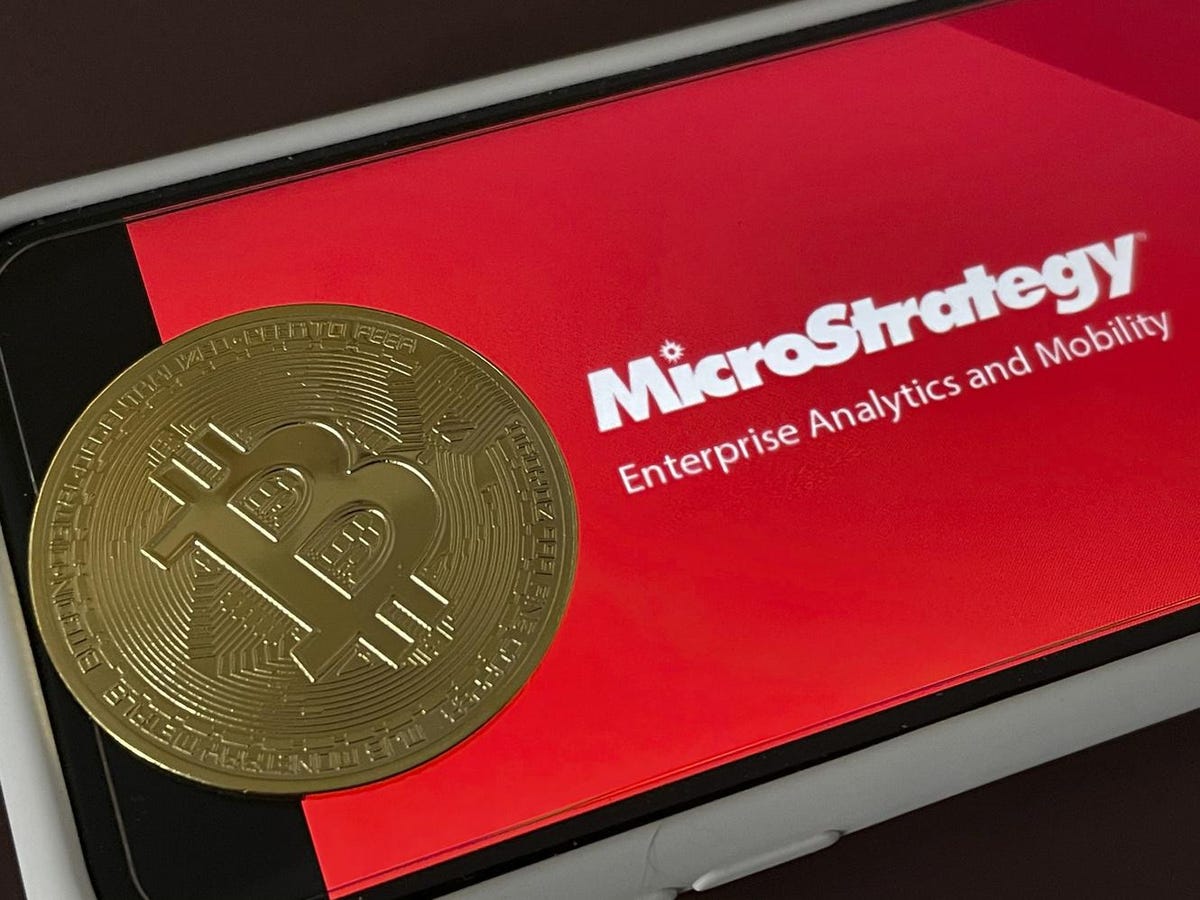Table of Contents
As of August 1, 2023, MicroStrategy bitcoin holdings are 152,800 bitcoins. According to the MicroStrategy announcement, the average buying price is $29,672 per bitcoin, for a total cost of $4.53 billion USD.
The concept of employing bitcoin as a hedge—a precaution against the devaluation of traditional currencies—is at the heart of MicroStrategy’s plan. In a period of extraordinary monetary stimulus and growing inflationary fears, the allure of a decentralized digital asset like bitcoin became clear.

The threat of currency depreciation loomed big as central banks produced more money. The flip by MicroStrategy was a resounding response—an acceptance of an asset that operates outside of traditional monetary regulations.
As bitcoin’s scarcity increased, so did its appeal as a hedge against inflation. The fixed quantity of 21 million coins stood in stark contrast to fiat currencies’ infinite printing capability.
The MicroStrategy bitcoin holdings have accumulated over a long period.
The decision by MicroStrategy to shift a major amount of its treasury holdings to bitcoin essentially effectively indicated that the corporation saw this digital asset as a store of value.
The use of bitcoin as a treasury reserve asset by MicroStrategy has raised debate regarding the role of cryptocurrencies in corporate finance.
Following the astonishing MicroStrategy bitcoin holdings, the idea of utilizing bitcoin as a hedge against traditional currency depreciation gained traction.
MicroStrategy, a tech behemoth, has been creating ripples in the world of digital currencies with its bold initiatives. MicroStrategy’s strategic purchases have attracted the attention of investors and industry fans alike since its debut into the realm of bitcoin. In this post, we go into the specifics, revealing the impact of MicroStrategy’s bitcoin purchases as well as the facts that back it up.
MicroStrategy bitcoin holdings over the last several months:
| Date | MicroStrategy Bitcoin Holdings |
| 8/1/2023 | 152,800 bitcoins |
| 4/29/2023 to 6/27/2023 | 152,333 bitcoins |
| April 5, 2023 | 140,000 bitcoins |
| March 23, 2023, | 138,955 bitcoins |
| December 24, 2022 | 132,500 bitcoins |
| December 22, 2022, | 131,690 bitcoins |
| 11/01/2022 to 12/21/2022 | 132,395 bitcoins |
| September 20, 2022 | 130,000 bitcoins |
| June 28, 2022 | 129,699 bitcoins |
| May 7, 2022 | 129,218 bitcoins |
| January 31, 2022 | 125,051 bitcoins |
| December 30th, 2021 | 124,391 bitcoins |
| 11/29/2021 to 12/08/2021 | 122,478 bitcoins |
| November 29th, 2021 | 121,044 bitcoins |
| September 13th, 2021 | 114,042 bitcoins |
| June 21st, 2021 | 105,085 bitcoins |
| May 18th, 2021, | 92,079 bitcoins |
| May 13th, 2021 | 91,850 bitcoins |
| April 5th, 2021 | 91,579 bitcoins |
| March 12th, 2021 | 91,326 bitcoins |
| March 5th, 2021 | 91,064 bitcoins |
The Bitcoin Adventure Begins
MicroStrategy Bitcoin holdings strategy begins in August 2020, when Michael Saylor, the company’s CEO, announced a strategic move of the company’s cash reserves into bitcoin.
This historic decision signaled the start of an unparalleled corporate acceptance of bitcoin.

Source forbes.com
Strategic Investing
MicroStrategy didn’t just dip its toes into the bitcoin pool; it dove in headfirst. Between August 2020 until the present, the corporation made a series of purchases, carefully accumulating bitcoin to hedge against inflation and maintain its capital.
The company’s acquisition strategy was based on consistency, with a dollar-cost averaging approach used to assure a disciplined accumulation of bitcoin over time.
MicroStrategy was able to acquire bitcoin at multiple price points thanks to the dollar-cost averaging strategy, ensuring a balanced introduction into the market. The company’s holdings have an average purchase price per bitcoin of roughly $26,080.
The strategic Bitcoin acquisitions made by MicroStrategy have had far-reaching consequences:
Pioneering Market Penetration
MicroStrategy’s entry into the bitcoin realm was analogous to throwing a spotlight on a sometimes-misunderstood stage. The mere act of a well-known publicly traded company allocating significant portions of its treasury holdings to bitcoin was a resounding declaration: cryptocurrencies are not just the domain of tech-savvy and adventurous investors; they are a legitimate asset class worthy of institutional consideration.
Institutions had been watching the bitcoin market with bated breath for years. Many experienced participants were put off by its volatility, regulatory worries, and status as a new asset class. The institution’s deliberate approach, on the other hand, struck a chord, defying institutional conservatism and inviting them to explore the potential beneath the surface.
MicroStrategy’s acceptance of bitcoin did more than raise eyebrows; it set off a chain reaction. As word of the company’s investments spread, other business executives began to rethink their own portfolios. If MicroStrategy, a well-known business consulting firm, discovered value in bitcoin, perhaps there was more to this digital currency than meets the eye.
This paradigm shift was a watershed moment. Other corporations began to investigate ways to incorporate bitcoin into their balance sheets as they saw the potential rewards and capacity to hedge against traditional economic risks. From IT firms to financial institutions, institutional involvement has widened the road for cryptocurrencies to enter mainstream portfolios.
The company’s aggressive entrance into bitcoin acted as a beacon of approval for institutional participation in the cryptocurrency sector. It paved the path for other businesses to consider incorporating bitcoin into their balance sheets.
Market Perception
One word that frequently takes center stage in the ever-changing world of cryptocurrencies is “volatility.” The rapid price swings and unpredictability of the market are enough to make even the most courageous investor’s head spin. Enter MicroStrategy, the game-changer who has given the market a new dimension by injecting a dose of steadiness.
The continuous bitcoin purchases by the company have had a significant impact on market dynamics, particularly in terms of perception. Consider a corporation that not only enters the bitcoin market but does so with a defined plan of measured accumulation. This calculated method, also known as dollar-cost averaging, entails spreading out purchases over time. It is a strategy that denotes a long-term commitment and belief in the value of the underlying asset.
The company’s constant purchases generated a feeling of stability in the market, which helped to mitigate the volatility normally associated with cryptocurrencies. This stability has contributed to improved investor and institutional confidence.
Bitcoin as a Treasury Reserve Asset
The concept of employing bitcoin as a hedge—a precaution against the devaluation of traditional currencies—is at the heart of MicroStrategy’s plan. In a period of extraordinary monetary stimulus and growing inflationary fears, the allure of a decentralized digital asset like bitcoin became clear. The threat of currency depreciation loomed big as central banks produced more money. The flip by MicroStrategy was a resounding response—an acceptance of an asset that operates outside of traditional monetary regulations.
As bitcoin’s scarcity increased, so did its appeal as a hedge against inflation. The fixed quantity of 21 million coins stood in stark contrast to fiat currencies’ infinite printing capability. The decision by Saylor to shift a major amount of the company’s treasury holdings to Bitcoin essentially effectively indicated that the corporation saw this digital asset as a store of value—a counterpoint to the uncertainty that typically surrounds the realm of finance.
The use of bitcoin as a treasury reserve asset by MicroStrategy has raised debate regarding the role of cryptocurrencies in corporate finance. Following MicroStrategy’s lead, the idea of utilizing bitcoin as a hedge against traditional currency depreciation gained traction.
Finally, the institution’s bitcoin purchases show that firms may diversify their treasury holdings outside traditional assets. As the numbers show, the company’s bitcoin holdings are massive, and the impact of its strategy on the broader financial ecosystem is apparent. MicroStrategy’s bitcoin voyage is an instructive odyssey worth following, whether you’re an investor, a market enthusiast, or simply intrigued about the developing environment of corporate finance.









